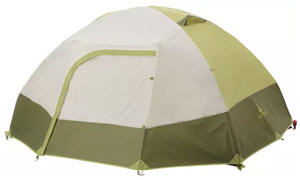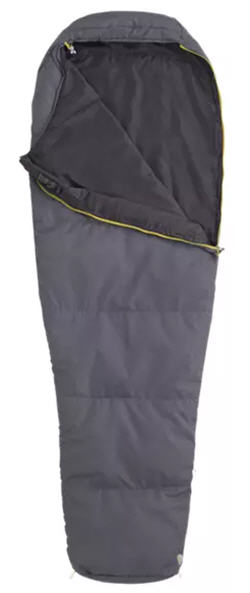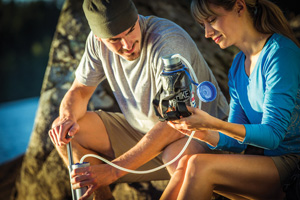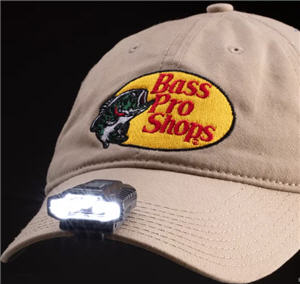
Getting away from it all to recharge the soul's batteries takes some dedication. If you really want to connect with the natural world, you'd be hard pressed to find and an activity more invigorating than backpacking. Yet, one factor that deters many would-be backpackers is the surrender of comfort. For those who've already experienced an ill-equipped backpacking trip, recollections of never ending treks up steep inclines and painful blisters probably flood the mind. It doesn't have to be this way. Experienced hikers who take to the trail with pack on the back regularly do so with affection, and they do it in relative comfort, too.

Click here to watch video or discover Ascend backpacks and bags in different sizes, styles and configurations at Bass Pro Shops.
Learning About Backpack Trip Planning
Proper planning is essential to a successful backpacking trip, and location is the first factor to consider when beginning the planning process. For first time backpackers, selecting a trail appropriate to skill level and physical ability is critical. Most bad backpacking experiences occur because people choose routes that turn out to be too difficult. If you're planning your first trip, avoid terrain with too many ascents, descents or difficult natural obstacles. Considering the age of participants, as well as their physical abilities, will lead to a contented group.
Planning your route on a topographical map will provide accurate details about varying elevations. A comfortable camp will not materialize if the day is spent trudging in pain up an unexpected incline. In other words, don't bite off more trail than you can chew...or walk.
Geographical ups and downs shouldn't be the only factors involved in trail selection — parking facilities at the trailhead, condition of the overnight campsite, local commerce (if any) and the nearest health care facility in case of emergency. (It's good to have a doctor close by and know how to find him if needed.)
Extra Tip: Plan a Backpack and Wilderness Fishing Trip
When selecting a trail, inquire with the managing personnel about specifics of not only the trail's contour, condition and challenges, but also things like drinking water availability and shelters. Knowing as much as possible about the trail's offerings will help you determine what gear is necessary and what gear to leave at home for later excursions. Each trail has an individual personality and should be approached differently when planning. Thorough preparation eliminates surprises and headaches that lead to foot and back pain, or worse, lost interest in returning for more backpacking action.
 Keeping the trip comfortable also depends on gear selection and use, which is determined well before departing the trailhead. The goal for nearly every backpacking trip is to go lightweight as possible. There are those who go ultra light or don't go at all, but going ultra light takes serious planning derived from multiple times on the packing trail. The key is to go as light possible without giving up quality and durability. This must be achieved to arrive at a comfy camp at the end of day. From boots and packs to food supplies and bedding, consider what is truly worth the extra weight and what isn't.
Keeping the trip comfortable also depends on gear selection and use, which is determined well before departing the trailhead. The goal for nearly every backpacking trip is to go lightweight as possible. There are those who go ultra light or don't go at all, but going ultra light takes serious planning derived from multiple times on the packing trail. The key is to go as light possible without giving up quality and durability. This must be achieved to arrive at a comfy camp at the end of day. From boots and packs to food supplies and bedding, consider what is truly worth the extra weight and what isn't.
Best Backpacking Experience - Comfortable Footwear & Clothing
A proper fitting hiking boot is priority as your feet are the foundation of the backpacking experience. Sore feet exaggerate the pain as it moves up your body, making it difficult to enjoy any part of the trip. Since you'll be carrying a load on your back, a boot with abundant ankle support is crucial, even with light loads. Maneuvering around and over rocks and logs, crossing streams and climbing and descending slopes will be much more comfortable with secure footwear.
Tip: Shop KEEN Targhee ll Waterproof Hiking Boot

Boots for Men
Dressing for the occasion is critical in backpacking, not for fashion, but for performance. Depending on the season, pants designed for the trip's terrain and conditions should be one of your first clothing considerations. The design to handle multiple events is zip-off legged pants, which go from long pants to shorts in a few seconds. These are perfect when dealing with elements such as cool mornings and warm days, or when wading small streams or wandering through knee-high vegetation. Another comfortable pant feature is an elastic waist band to eliminate the need for a belt. With a backpack waist belt snuggly wrapped around you, the absence of a constricting belt will be appreciated.
Dressing for comfort while backpacking is a bit different than when hiking. Keeping cool or warm while exerting energy to walk and pack onward is a constant task. The objective is to maintain a stable temperature. Stopping occasionally to add a shirt or remove a jacket in reaction to the course is common. Re-hydrating will also help the body to maintain a stable temperature, as will layering in sufficient clothing layers, but not too many layers. Wearing a base layer shirt made of athletic-type material wicks away moisture and provides proper ventilation. A lightweight, breathable windbreaker is a good cover all, especially if rain showers are in the forecast.
Backpacks, Tents & Sleeping Bags
Backpacks come in many styles, designs and weights. Three elements should be satisfied: fitting to individual's size, balance of pack when loaded and (keeping with the theme of this article) comfort. A small teenager porting their gear in an adult-sized pack will likely lead to overloading. An adult toting a pack that's too small causes under-supplied situations. Select a pack that is proportionate to body height and weight. An internal-framed pack fits the body snugly, whereas an external pack straps on with ventilation space between pack and back. An internal pack is more stable when the going gets rough because of the tighter fit. An external pack is slightly less steady, but it is easier to load and access gear.
Extra Tip: 10 Backpacking Essentails You Shouldn't Forget
Click here to discover Ascend backpacks and bags in different sizes, styles and configurations at Bass Pro Shops.

Narrowing down the perfect backpacking tent is simple — buy the best you can afford. The reason is this: if you're on a two-day trip and it rains for one-and-a-half days, chances are more time than expected will be spent snuggled into the fabric lodge. Also, set up and tear down your tent a few times at home. Arriving at a backcountry campsite near or after dark can quickly turn into a major headache if you don't already know how to set up your tent. When considering tents for backpacking, be sure to choose a shelter with lightweight poles and stakes, as well as one that is lightweight overall — every ounce counts in backpacking.

Mummy Sleeping Bag
Extra Tip: 12 Tips for Packing a Backpack plus video
Settling into a quality sleeping bag after hours of roving the trail is pleasurable and satisfying. Doing so in an ill-performing bag is not. Sleeping bags designed for backpacking get the nod here; they're durable, lightweight and compress to a smaller, easily packable size. Be mindful the trip is planned around walking and exploration, not a slumber party that requires an oversized sleeping sack for two. However, consider a lightweight sleeping pad to provide an extra barrier between you and the ground. Some believe a pad is an extra, but for a decent night's sleep, I'd include one.
Food & Water on the Trail
Meals on the trail don't have to be granola bars, but a backpack loaded down with tons of cooking gear isn't desirable either. Freeze dried camp food meals fit well in a pack and are easy on the back. Add a few strips of beef jerky for a low-fat, high-energy snack to keep the body fueled for the strenuous journey. Focus on drinking water throughout the trip, tossing in a few packets of water-flavoring powder just for fun.
 Packing in the gallons of water needed to sustain health and comfort on a multi-day trip is normally not feasible. A portable water purifier will handle filtration duties from lake or stream water. Even developed spring wells located along established trails should be run through a filter. There is no enjoyment to be had in spending hours perched privately off the trail battling diarrhea.
Packing in the gallons of water needed to sustain health and comfort on a multi-day trip is normally not feasible. A portable water purifier will handle filtration duties from lake or stream water. Even developed spring wells located along established trails should be run through a filter. There is no enjoyment to be had in spending hours perched privately off the trail battling diarrhea.
Extra Tip: 10 Tasty Backpacking Snacks
Outdoor Gear to Keep Handy When Backpacking

Keeping the pack's side pockets supplied with compass, GPS unit, maps, guidebooks, headlamp, rain jacket and first-aid kit will allow quick access. At home, pack the pack in a few different arrangements to see what works best.
Tip: Shop Bass Pro Shops Backpacker First Aid Kit here
Think through possible scenarios, both comfortable and uncomfortable, to ensure all gear items are placed in the pack according to priority and frequency of use. If an extra pound can be handled, add a camera, as the experience should be documented. If picture is worth a thousand words, a dozen photos can tell the whole story. If the trip is a comfortable one, goal achieved. If not, reflect on the excursion to see where you can improve.
- 9786 views

